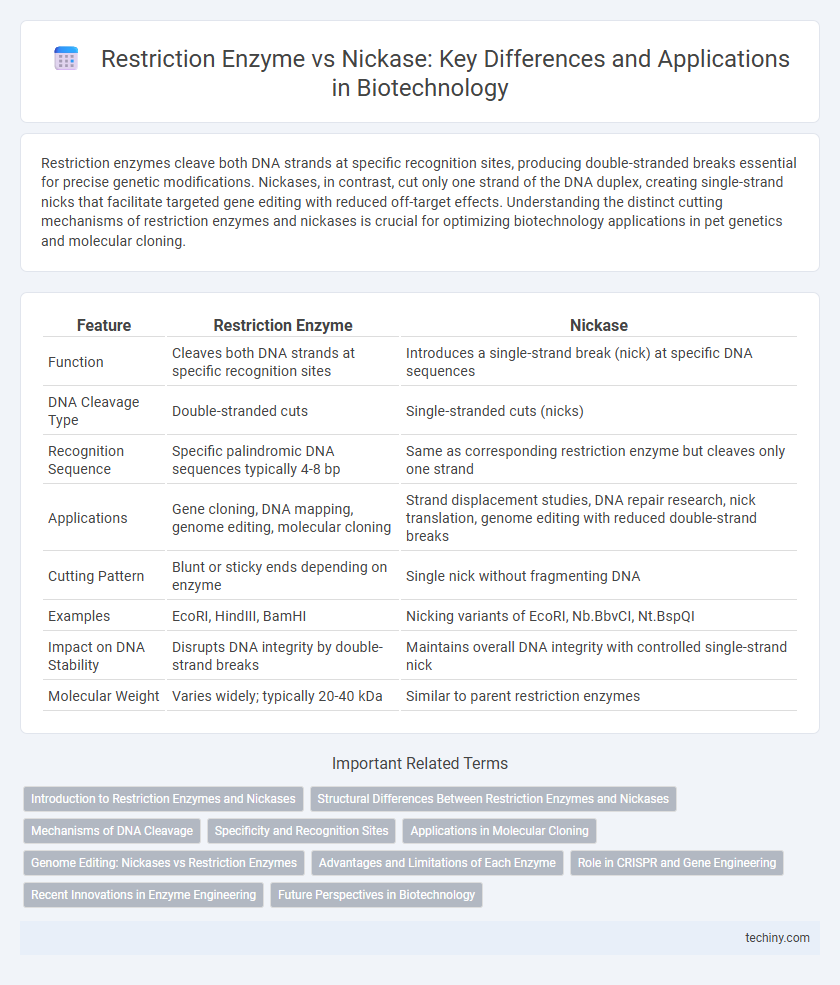Restriction enzymes cleave both DNA strands at specific recognition sites, producing double-stranded breaks essential for precise genetic modifications. Nickases, in contrast, cut only one strand of the DNA duplex, creating single-strand nicks that facilitate targeted gene editing with reduced off-target effects. Understanding the distinct cutting mechanisms of restriction enzymes and nickases is crucial for optimizing biotechnology applications in pet genetics and molecular cloning.
Table of Comparison
| Feature | Restriction Enzyme | Nickase |
|---|---|---|
| Function | Cleaves both DNA strands at specific recognition sites | Introduces a single-strand break (nick) at specific DNA sequences |
| DNA Cleavage Type | Double-stranded cuts | Single-stranded cuts (nicks) |
| Recognition Sequence | Specific palindromic DNA sequences typically 4-8 bp | Same as corresponding restriction enzyme but cleaves only one strand |
| Applications | Gene cloning, DNA mapping, genome editing, molecular cloning | Strand displacement studies, DNA repair research, nick translation, genome editing with reduced double-strand breaks |
| Cutting Pattern | Blunt or sticky ends depending on enzyme | Single nick without fragmenting DNA |
| Examples | EcoRI, HindIII, BamHI | Nicking variants of EcoRI, Nb.BbvCI, Nt.BspQI |
| Impact on DNA Stability | Disrupts DNA integrity by double-strand breaks | Maintains overall DNA integrity with controlled single-strand nick |
| Molecular Weight | Varies widely; typically 20-40 kDa | Similar to parent restriction enzymes |
Introduction to Restriction Enzymes and Nickases
Restriction enzymes, also known as restriction endonucleases, are proteins that precisely cut double-stranded DNA at specific recognition sites, enabling genetic mapping and molecular cloning. Nickases are specialized variants of restriction enzymes that introduce single-strand breaks or nicks in DNA without fully cleaving both strands, useful for applications requiring targeted strand-specific modifications. Both enzymes play crucial roles in genetic engineering, with restriction enzymes facilitating DNA fragment manipulation and nickases enabling precise genome editing and repair studies.
Structural Differences Between Restriction Enzymes and Nickases
Restriction enzymes typically cleave both strands of the DNA helix, creating double-strand breaks with specific recognition sites, whereas nickases selectively cut only one strand, generating single-strand nicks. Structurally, restriction enzymes possess two catalytic domains that coordinate the hydrolysis of phosphodiester bonds across both strands, while nickases have a modified or inactive catalytic site on one domain, enabling strand-specific cleavage. This structural divergence underpins their distinct biochemical functionalities and applications in molecular cloning and genome editing.
Mechanisms of DNA Cleavage
Restriction enzymes recognize specific palindromic DNA sequences and cleave both strands, generating double-strand breaks crucial for molecular cloning. Nickases, derived from restriction enzymes, selectively cut only one DNA strand, producing single-strand nicks that enable targeted genetic modifications with reduced genome disruption. The cleavage specificity and strand-targeting mechanisms differentiate their applications in genome editing and recombinant DNA technology.
Specificity and Recognition Sites
Restriction enzymes cleave double-stranded DNA at specific recognition sites, typically 4 to 8 base pairs long, exhibiting high specificity that enables precise genetic manipulation. Nickases, a subclass of restriction enzymes, introduce single-strand breaks (nicks) rather than double-strand cuts at their recognition sequences, allowing more controlled modifications such as strand displacement or repair studies. The distinction in cleavage activity between restriction enzymes and nickases impacts their application in molecular cloning, gene editing, and DNA nanotechnology, with nickases providing targeted single-strand modifications without disrupting the overall double-strand structure.
Applications in Molecular Cloning
Restriction enzymes cleave DNA at specific recognition sites, enabling precise cutting and insertion of genetic material in molecular cloning. Nickases introduce single-strand breaks, facilitating targeted modifications such as site-directed mutagenesis and strand displacement amplification. Their application in cloning strategies improves efficiency and accuracy in gene editing and recombinant DNA technology.
Genome Editing: Nickases vs Restriction Enzymes
Restriction enzymes are widely used in genome editing for their ability to create double-strand breaks at specific DNA sequences, facilitating targeted gene modification. Nickases introduce single-strand breaks or nicks, offering higher precision and reduced off-target effects in techniques like base editing and prime editing. Their selective cleavage improves DNA repair accuracy, making nickases valuable tools for refined genome manipulation compared to traditional restriction enzymes.
Advantages and Limitations of Each Enzyme
Restriction enzymes offer precise DNA cleavage at specific recognition sites, enabling efficient genetic mapping and cloning, but their activity can be limited by site availability and potential off-target effects. Nickases introduce single-strand breaks, reducing double-stranded DNA damage and enhancing genome editing precision, though they may require paired recognition sites and often exhibit lower cleavage efficiency. Both enzymes provide valuable tools in biotechnology, with selection dependent on desired specificity, target sequence, and application requirements.
Role in CRISPR and Gene Engineering
Restriction enzymes cleave double-stranded DNA at specific recognition sites, enabling precise gene editing in CRISPR applications by creating double-strand breaks for targeted DNA modification. Nickases, a modified form of restriction enzymes, introduce single-strand cuts or nicks, reducing off-target effects and improving specificity in gene engineering by facilitating homology-directed repair. Both enzymes are essential for optimizing CRISPR efficiency and accuracy in genetic manipulation and therapeutic development.
Recent Innovations in Enzyme Engineering
Recent innovations in enzyme engineering have led to the development of highly specific restriction enzymes and nickases that enhance genome editing precision. Advanced techniques like directed evolution and protein engineering have improved enzyme stability, target recognition, and cleavage efficiency, enabling diverse applications from gene therapy to synthetic biology. Cryo-electron microscopy and computational modeling drive the design of novel variants with tailored activity, expanding the toolkit for precise DNA manipulation.
Future Perspectives in Biotechnology
Restriction enzymes and nickases both play pivotal roles in genome editing, with future biotechnology trends emphasizing enhanced precision and minimized off-target effects. Advances in engineering nickases aim to harness their single-strand cleavage activity for more controlled gene modification, reducing unintended DNA damage compared to double-strand cuts by restriction enzymes. Integrating these tools with CRISPR-Cas systems is projected to revolutionize targeted therapies, synthetic biology, and agricultural biotechnology through improved specificity and efficiency.
Restriction Enzyme vs Nickase Infographic

 techiny.com
techiny.com